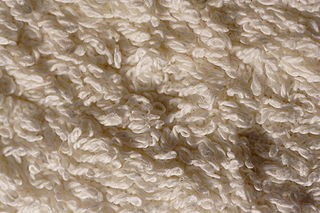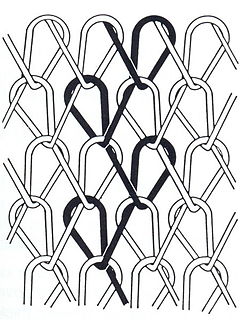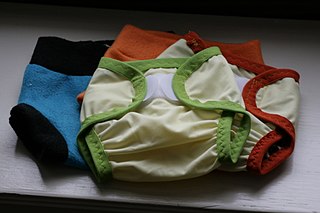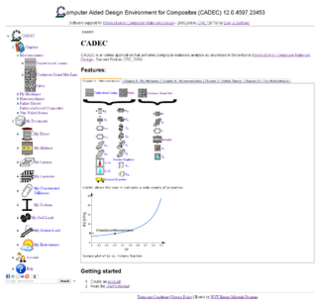
Polytetrafluoroethylene (PTFE) is a synthetic fluoropolymer of tetrafluoroethylene that has numerous applications. The commonly known brand name of PTFE-based formulas is Teflon by Chemours, a spin-off from DuPont, which originally discovered the compound in 1938. Another popular brand name of PTFE is Syncolon by Synco Chemical Corporation.

Plywood is a material manufactured from thin layers or "plies" of wood veneer that are glued together with adjacent layers having their wood grain rotated up to 90 degrees to one another. It is an engineered wood from the family of manufactured boards which include medium-density fibreboard (MDF) and particle board (chipboard).

Spandex, Lycra or elastane is a synthetic fiber known for its exceptional elasticity. It is a polyether-polyurea copolymer that was invented in 1958 by chemist Joseph Shivers at DuPont's Benger Laboratory in Waynesboro, Virginia.

Engineered wood, also called mass timber, composite wood, man-made wood, or manufactured board, includes a range of derivative wood products which are manufactured by binding or fixing the strands, particles, fibres, or veneers or boards of wood, together with adhesives, or other methods of fixation to form composite material. The panels vary in size but can range upwards of 64 by 8 feet and in the case of cross-laminated timber (CLT) can be of any thickness from a few inches to 16 inches or more. These products are engineered to precise design specifications, which are tested to meet national or international standards and provide uniformity and predictability in their structural performance. Engineered wood products are used in a variety of applications, from home construction to commercial buildings to industrial products. The products can be used for joists and beams that replace steel in many building projects. The term mass timber describes a group of building materials that can replace concrete assemblies. Broad-base adoption of mass timber and their substitution for steel and concrete in new mid-rise construction projects over the next few decades has the potential of turning timber buildings into a global carbon sink, which could help mitigate climate change.

Nomex is a flame-resistant meta-aramid material developed in the early 1960s by DuPont and first marketed in 1967.

A scrim is a woven material, either finely woven lightweight fabric widely used in theatre, or a heavy, coarse woven material used for reinforcement in both building and canvasmaking.

Sailcloth encompasses a wide variety of materials that span those from natural fibers, such as flax, hemp or cotton in various forms of sail canvas, to synthetic fibers, including nylon, polyester, aramids, and carbon fibers in a variety of woven, spun and molded textiles.
Windstopper is a generic term used by many companies in the outdoors clothing market. W. L. Gore & Associates uses the word to label its windproof breathable fabric laminate. One of its most common applications is a lamination with polar fleece, to compensate for fleece's lack of wind resistance.

Terrycloth, terry cloth, terry cotton, terry towelling, terry, terry towel or simply towelling is a fabric woven with many protruding loops of thread, which can absorb large amounts of water. It can be manufactured by weaving or knitting. Terrycloth is woven on special looms that have two beams of longitudinal warp through which the filler or weft is fired laterally. The first industrial production of terrycloth towels was initiated by the English manufacturer Christy in 1850. According to the Oxford English Dictionary, the word may derive from French tiré 'drawn', past participle of tirer 'draw out'.

Warp knitting is a family of knitting methods in which the yarn zigzags along the length of the fabric; i.e., following adjacent columns, or wales, of knitting, rather than a single row, or course. For comparison, knitting across the width of the fabric is called weft knitting.

Polyurethane laminate is a compound fabric made by laminating a cloth fabric to one or both sides of a thin film of polyurethane. Polyurethane laminated fabrics have a wide range of applications in medical, automotive and garment uses.

Laminated glass is a type of safety glass that holds together when shattered. In the event of breaking, it is held in place by an interlayer, typically of polyvinyl butyral (PVB), ethylene-vinyl acetate (EVA), or Thermoplastic Polyurethane (TPU), between its two or more layers of glass. The interlayer keeps the layers of glass bonded even when broken, and its high strength prevents the glass from breaking up into large sharp pieces. This produces a characteristic "spider web" cracking pattern when the impact is not enough to completely pierce the glass. In the case of the EVA, the thermoset EVA, offers a complete bounding (cross-linking) with the material whether it is glass, polycarbonate, PET, or other types of products. TPU is the best choice for Bullet-Resistant Glass (BRG) and for so called E-Glass.

Dyneema Composite Fabric (DCF), also known as Cuben Fiber (CTF3), is a high-performance non-woven composite material used in high-strength, low-weight applications. It is constructed from a thin sheet of ultra-high-molecular-weight polyethylene laminated between two sheets of polyester.
Safety and security window films are polyester, or PET films that are applied to glass and glazing in order to hold them together if the glass is shattered. The main difference between film and laminated glass is that these Shatter Safe films can be applied to the glass or glazing after manufacture or installation, i.e., it is a retrofit product. These films are used widely all over the world; they can be found on trains, buses, cars, and buildings.

OMNOVA Solutions Inc., is a global manufacturer of emulsion polymers, specialty chemicals, and functional and decorative surfaces. OMNOVA was founded in 1999 when GenCorp spun off its Decorative & Building Products and Performance Chemicals businesses into a separate, publicly traded company. OMNOVA's world headquarters is located in Beachwood, Ohio with additional sales, manufacturing and distribution locations throughout Europe and Asia.
In architecture, fabric structures are forms of constructed fibers that provide end users a variety of aesthetic free-form building designs. Custom-made fabric structures are engineered and fabricated to meet worldwide structural, flame retardant, weather-resistant, and natural force requirements. Fabric structures are considered a sub-category of tensile structure.
Three-dimensional composites use fiber preforms constructed from yarns or tows arranged into complex three-dimensional structures. These can be created from a 3D weaving process, a 3D knitting process, a 3D braiding process, or a 3D lay of short fibers. A resin is applied to the 3D preform to create the composite material. Three-dimensional composites are used in highly engineered and highly technical applications in order to achieve complex mechanical properties. Three-dimensional composites are engineered to react to stresses and strains in ways that are not possible with traditional composite materials composed of single direction tows, or 2D woven composites, sandwich composites or stacked laminate materials.

cadec-online.com is a multilingual web application that performs analysis of composite materials and is used primarily for teaching, especially within the disciplines of aerospace engineering, materials science, naval engineering, mechanical engineering, and civil engineering. Users navigate the application through a tree view which structures the component chapters. cadec-online is an engineering cloud application. It uses the LaTeX library to render equations and symbols, then Sprites to optimize the delivery of images to the page.
Composite repairs. Composite materials are used in a wide range of applications in aerospace, marine, automotive, surface transport and sports equipment markets. Damage to composite components is not always visible to the naked eye and the extent of damage is best determined for structural components by suitable Non Destructive Test (NDT) methods. The concept for composite repair of composite or metallic structures is simple. The bonded repair reduces stresses in the damaged region and keeps the cracks from opening and therefore from growing.
A Lay-Up process is a moulding process for composite materials, in which the final product is obtained by overlapping a specific number of different layers, usually made of continuous polymeric or ceramic fibres and a thermoset polymeric liquid matrix. It can be divided into Dry Lay-up and Wet Lay-Up, depending on whether the layers are pre-impregnated or not. Dry Lay-up is a common process in the aerospace industry, due to the possibility of obtaining complex shapes with good mechanical properties, characteristics required in this field. On the contrary, as Wet Lay-Up does not allow uni-directional fabrics, which have better mechanical properties, it is mainly adopted for all the other areas, which in general have lower requirements in terms of performances.
The main stages of the Lay-Up process are the cutting, the lamination and the polymerization. Even if some of the production steps can be automatised, this process is mainly manual, leading to laminates with high production costs and low production rates with respect to the other techniques. Hence, nowadays, it is mainly suitable for small series productions of 10 to 1000 parts.
















